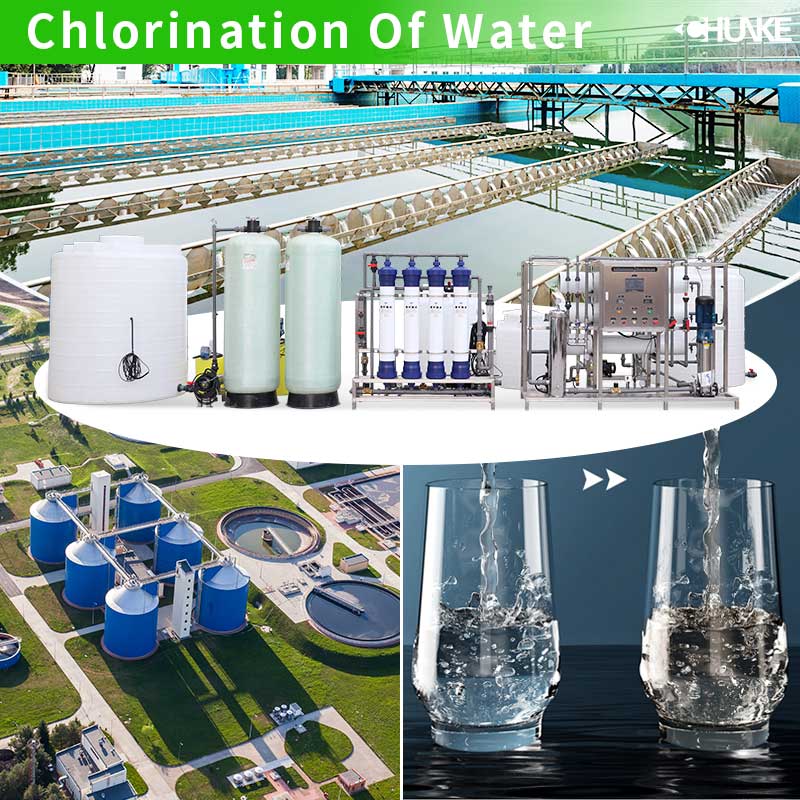-
05-15 2024
What is a filter house?
A filter house refers to a building or facility used for water treatment, which contains various filters and filter materials to remove impurities and pollutants from water. The filter house is usually an important part of the water treatment plant. Its design and operation affect the purification effect and treatment efficiency of water quality.
-
05-15 2024
What is the process of chlorination of water?
The chlorination of water process refers to adding chlorine gas or other chlorides to water to make the water contain a certain concentration of chloride ions to achieve the purpose of disinfection and sterilization. In the chlorination of water process, commonly used chlorination agents include chlorine gas, sodium hypochlorite, chloramine, etc.
-
05-14 2024
What is permanent hardness in water and how to remove it?
The permanent hardness of water mainly comes from the calcium sulfate and magnesium sulfate in the water. The main methods for removal of permanent hardness of water include ion exchange and adding complexing agents. Ion exchange is the adsorption of calcium and magnesium ions in water through ion exchange resin. Adding a complexing agent is by adding a certain amount of complexing agent to the water.
-
05-14 2024
What is the purpose of using effluent water?
The purpose of using effluent water: 1. Improve water resource utilization efficiency 2. Reduce pollution to natural water bodies 3. Reduce operating costs of effluent water treatment plants
-
05-13 2024
What are the remedies of water pollution?
1. Water body management and protection One of the remedies for water pollution is water treatment and protection. 2. Ecological restoration and reconstruction Ecological restoration and reconstruction is one of the important means to alleviate water pollution. 3. New technology application and research and development The application and research and development of new technologies are crucial to solving water pollution problems.
-
05-13 2024
What is a water disinfection system?
Water disinfection system refers to a system that uses chemical methods to attack and eliminate germs (such as bacteria, fungi) and viruses in water. It ensures the safety of drinking water by adding specific disinfectants to kill microorganisms in the water.
-
05-10 2024
What is the role of an industrial water treatment plant?
The main function of industrial water treatment plants is to purify industrial wastewater and ensure that its discharge meets environmental protection standards, thereby reducing environmental pollution. Different types of industrial activities produce a wide variety of wastewater, including chemicals, heavy metals, organic matter, etc. Direct discharge of these wastewater without treatment will pose serious threats to water bodies, soil and biodiversity.
-
05-10 2024
What does RO in water plant mean?
Reverse osmosis (RO) is a common process for purifying or desalinating contaminated water by forcing it through a semipermeable membrane. This technology creates pure water by applying pressure to move water through a membrane, expelling impurities, salts, and other contaminants from the water. The pore size of the reverse osmosis membrane is extremely small, usually about 0.0001 micron, and can effectively filter out small impurities.
-
05-09 2024
What is borehole water?
Desalination is generally not required. Borehole water is a water source extracted from deep underground through drilling technology. This water usually comes from underground aquifers, which can range in depth from tens to hundreds of meters. Because borehole water comes from deep underground, it is generally less susceptible to surface contamination and is considered a high-quality water source in many areas. Therefore, it can be drunk directly without desalination.
-
05-09 2024
Can reverse osmosis water purifiers remove microplastics?
Reverse osmosis water purifiers can effectively remove microplastics. This is due to its advanced filtration process and the extremely small pore size of the semi-permeable membrane. The reverse osmosis system achieves efficient removal of microplastics mainly through three aspects: filtration accuracy, efficient filtration process, and removal of various pollutants.














